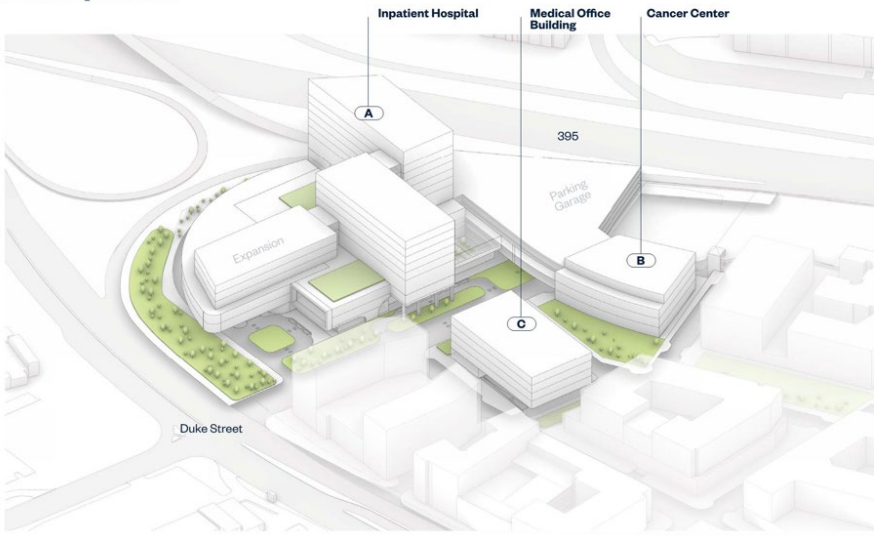Neya Alper
Once home to a multitude of shops, stores, and restaurants, the Landmark Mall now sits empty and closed. The mall has undergone several changes in the past, first opening as an outdoor mall in 1965. When Sears finally closed in 2020, Alexandria was quick to start making plans on what to do with the 52-acre site.
In a news release in December, the city revealed their most recent plans regarding the mall. Partnered with Foulger-Pratt (a local real estate development firm), the Howard Hughes Corporation (a real estate development and management company), Seritage Growth Properties (a real estate investment trust), and Inova Health System (a nonprofit healthcare provider), the City of Alexandria plans to create “a mixed-use, walkable urban village,” including a newer and better hospital campus. It also would include “residential, retail, commercial, and entertainment offerings” along with parks and other public spaces. Other probable additions include a fire station and a bus transit hub.
The new Inova facility at the site will be a 230-bed hospital with all private rooms. The emergency room will be larger than other facilities, and it will also include a Level II Trauma service, one of the only ones in Northern Virginia, which can be used to treat brain trauma and more difficult fractures. The facility will also feature a cancer center that offers both radiation and infusion treatment. Along with the new hospital, a building for medical offices will also be constructed, where 50 speciality physicians can see and care for both inpatients and outpatients. The facility will also be built with the future in mind, keeping the design and functionality flexible to accommodate for future changes in healthcare.
“By having all three facilities (an acute tertiary care hospital, a comprehensive cancer center, and a medical office building) all in one location, we will truly be able to meet the needs of the residents of Alexandria from an outpatient perspective as well as an inpatient perspective,” said President of the current Inova Alexandria Hospital Dr. Rina Bansal.

Along with providing a complete healthcare service, another intention for the redevelopment of the site is to create a gathering place for people within the West End of Alexandria as well as others who wish to visit.
“We’ve said this is a gathering place for all. Well, how are we making this a gathering place for all if you aren’t visiting the hospital or the retail or living at Landmark?” said Brigg Bunker, a managing partner and Chief Operating Officer at Foulger-Pratt. “And so, we have created a series of public spaces, from a central plaza to smaller pocket parks to the way that the streets and sidewalks are designed.”
The site will also include retail, which the designers hope will bring people to the site, and the restaurants, entertainment options, and open space will encourage the people to stay. To accommodate this goal, there will be “ample parking” at the site, a transit hub where people can use public transportation to get to and from the site, and improved connections with the surrounding streets, Van Dorn and Duke.
Although there have been multiple attempts to redevelop the mall in the past, the team working on it currently believes that this time will be different from previous attempts in that it will actually be completed. In a community outreach meeting on January 4, CEO of Foulger-Pratt Cameron Pratt listed three reasons why.
“There are three primary things that make it different this time, [the] first and foremost [being] Inova’s decision to relocate Alexandria’s hospital to this site,” Pratt said. Prior to this, most development firms had envisioned the spot to be anchored with retail. But, as Pratt explained, “the world of retail has been dramatically changing, and the last year has accelerated all those changes.” Inova’s agreement to relocate the hospital provided the developers with a studier node to build the community around.
The second reason is the involvement of a local developer, Foulger-Pratt. The two other developers that have previously worked on this project, Howard Hughes and Seritage, are based in Texas and New York respectively.
“Our deep roots in Northern Virginia and in the city of Alexandria help us to come in and look at the project with new eyes,” Pratt said. The modification that Foulger-Pratt offered to the existing plans made by the two existing developers will help bring this project to a reality. As Pratt explained, “the small area was adopted in 2009 and amended in 2019… We wanted to make sure that anything we were doing here was honoring all that work.”
Lastly, the third reason is the constant presence of the support from the city of Alexandria combined with the other two factors.
“The mayor, the city manager, and the entire staff that we have worked very closely with the last year has been unwavering in their support to find the right plan that would work for Inova, for the landowners, for potential investors, and also for the citizens of the city of Alexandria,” Pratt said.

This project will also affect and alter the traffic patterns in and around the site. Traffic in regards to a mall site is very different from the future vision of an urban village. More entrances to the site will be created, along with better access for cyclists and pedestrians. There are not any specifics as to how the traffic patterns will be affected, but the city has said that they will complete a traffic analysis of the site and consult the Federal Highway Administration and the Virginia Department of Transportation.
None of the plans are set in stone yet, but the city, along with the other contributors to this project, have drafted a tentative schedule and budget. The proposal is expected to be confirmed so the project demolition and construction can commence in 2023. The first buildings should open up sometime in 2025. It is all very preliminary at this point, and only rough timelines have been made. The cost of this project is estimated to be around $130 million, taken from public bond funds, which support projects by the city that benefit the community at large. The $130 million includes the $54 million needed to buy the land to lease to Inova and the $76 million to prepare and develop the site.





